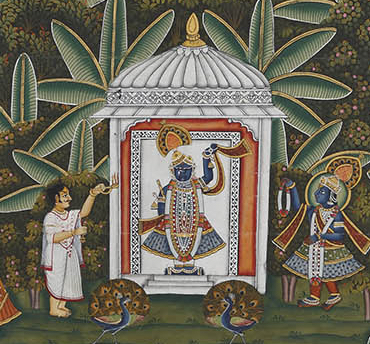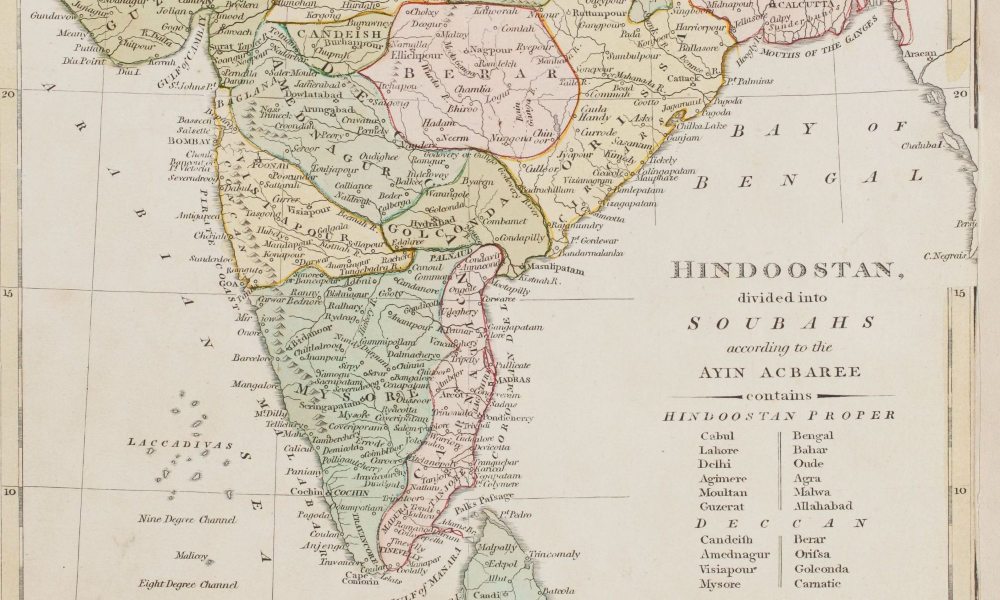
'Hindoostan divided into soubahs according the Ayin-Acbaree' showing the Deccan empires in the time of Mughal Emperor Akbar, published 1815 by R Wilkinson © Sarmaya Arts Foundation
The history of any region is pieced together through artefacts left by the wealthy few- kings, queens and courtiers. We inspect their court records, their architectural investments, the inscriptions they leave on the structures, their coins and interpret the meanings behind their actions. In most cases, what survives is subject to the materiality of the artefacts and the interests of societies past, often leading to gaps in even the most comprehensively curated chronologies. The early history of the Deccan remains fragmented due to these gaps. According to Anirudh Kanisetti, historian and author of Lords of the Deccan: Southern India from the Chalukyas to the Cholas, this fragmentation is further complicated by a general academic neglect of the region’s complex political entities.
The word Deccan comes from a corruption of the Sanskrit dakshina, meaning the south, and it corresponds to the peninsular region south of the river Narmada. Geologically, it refers to a plateau that came into existence 66 million years ago and is inhabited by the modern states of Maharashtra, Karnataka, Telangana, Andhra Pradesh, Kerala and Tamil Nadu. Culturally, the Deccan is divided into three major linguistic zones ie Telugu, Kannada and Marathi, besides being home to a variety of faiths and communities. It has nurtured some of India’s most beloved traditions, from the cave art of Ellora to Carnatic music, and from Kalamkari textiles to shadow puppetry.
The Deccan’s diversity of art, culture and language is the result of centuries of shifting politics. In this feature, based on an interview with Kanisetti, we will focus on the prominent early and late-mediaeval kingdoms of this vast region, as represented by the rare photographs, coins, books, engravings and maps from the Sarmaya collection. As you will see, contemporary India still carries the remarkable imprints of their reign.
We will start in the 6th Century with the Chalukyas, follow the rise of the Rashtrakutas, observe the tumultuous reign of the Bahmani Sultanate, and recount the fortunes of the Vijayanagara empire and the Deccan Sultanates, ending our journey a thousand years later in the 17th Century.
Chalukyas
The Chalukyas rose to power in the late 6th century, when the Deccan was governed by local chiefs, thus open to raids and harassment. Named for their weapon of choice, the chalke or crowbar, this clan learnt the art of war and rose to power within three generations. In 543 CE the ruler of the clan conducted the Ashwamedha yagna to legitimise his overlordship in and around Vatapi in present-day Badami, Karnataka. Post the ritual, he gave himself the title Pulakesin I, ‘the Great Lion’, and the Chalukyas became an imperial dynasty. They would rule the Deccan for more than 500 years, subjugating the Kadambas, Kalachuris, Gangas and the Pallavas in the south, and repelling the Maitrikas and Pushyabhutis in the north. The expansion was strategic and captured both the west and east coasts to bring in a flow of revenue from trade. At its peak in 682 CE, the Chalukyas ruled an area that spread from southern Gujarat all the way to the borders of the Tamilakam or Tamil country.
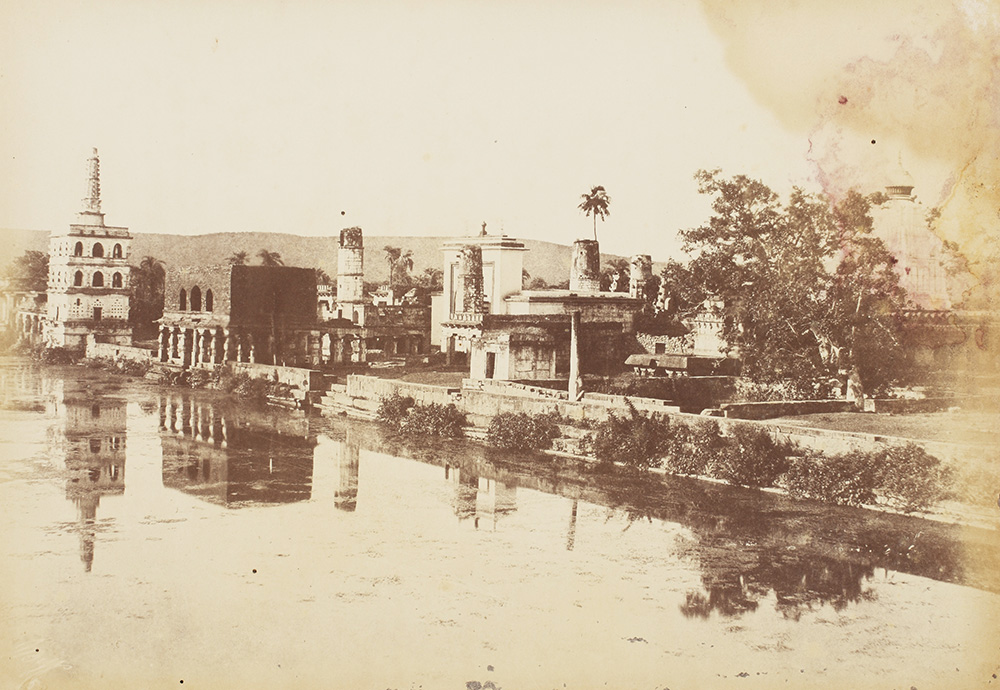
Banashankari group of temples built by the Badami Chalukyas, Badami, 1855, Thomas Biggs © Sarmaya Arts Foundation
Being the first mediaeval kingdom to rule over most of the Deccan peninsula, the Chalukyas would set the stage for later dynasties. They were the first to name themselves the descendants of Lord Vishnu in the Deccan, following the lead of the Gupta Empire in the north. Rulers took the title of Sri-Prithvi-Vallabha, meaning an incarnation of Vishnu (Vallabha), favoured by fortune (Sri) and beloved of the Earth (Prithvi).
In 660CE, they would again be the first to embrace Shiva-worship to gain the support of increasing followers, teachers and institutions in the region. They would also become skilled at visual propaganda by building temples carrying political messages. For example, King Mangalesha would commission an image of Varaha in the Cave 3 of Badami that drew parallels between his own campaign against the Kadambas and Vishnu’s saving of the Earth from darkness. Time and again, the Chalukyas would build religious centres to shore up political mileage and establish new streams of revenue.
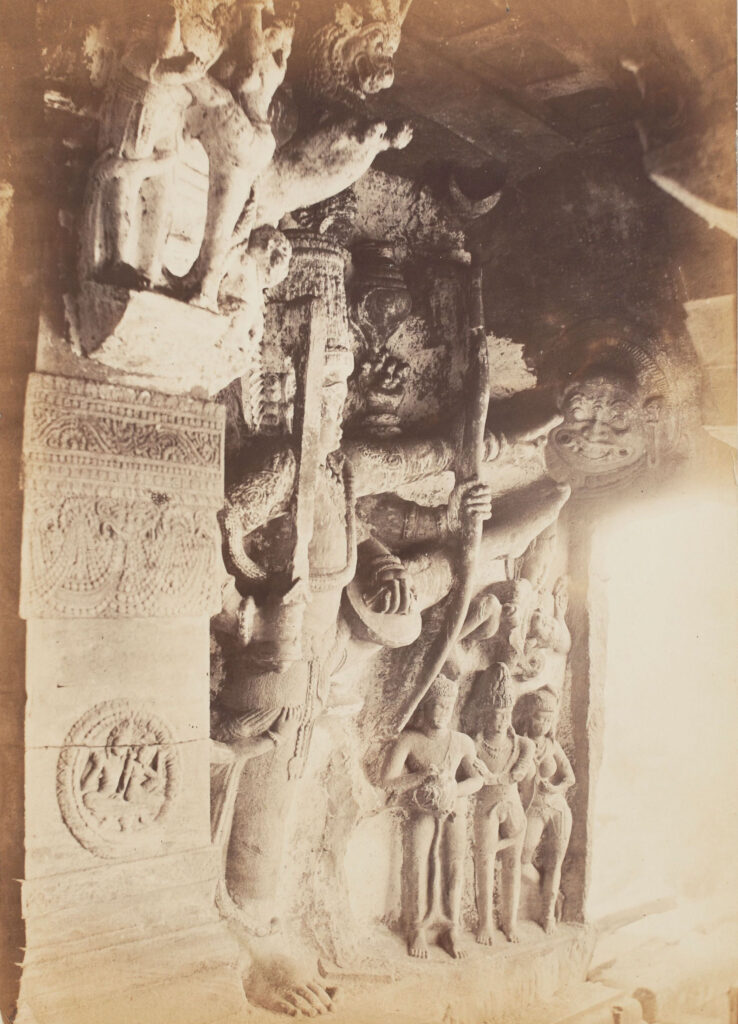
Cave 3 at Badami with sculpture of Lord Vishnu in the Vamana avatar, 1874, image © Sarmaya Arts Foundation
The growth of these religious complexes and vassal states led to the rise of powerful local rulers and factions within the family, like the Chalukyas of Vengi and Chalukyas of Lata.
Rashtrakutas
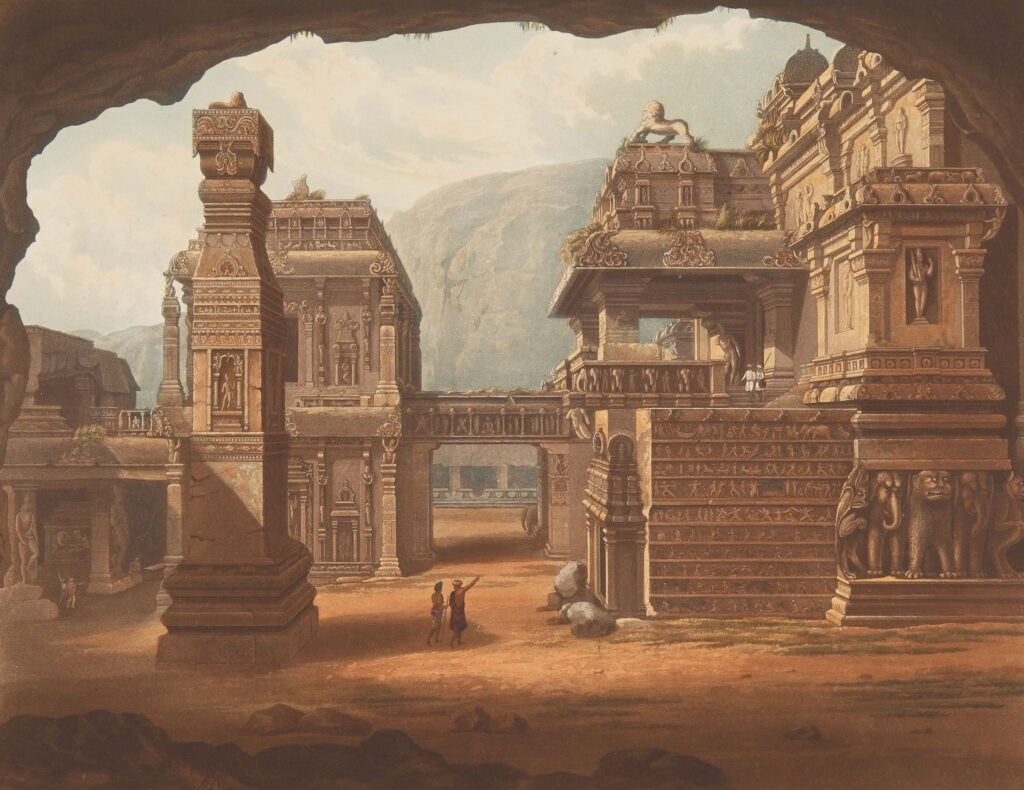
Kailasha Temple, Ellora Caves, Aurangabad, 1826, Robert Melville Grindlay © Sarmaya Arts Foundation
The Rashtrakuta dynasty was established by Dantidurga, a vassal of the Chalukyas under Vikramaditya II. Dantidurga was the son of Rashtrakuta ruler, Indra, and Lata Chalukya princess, Bhavanaga. Both Bhavanaga and her son were astute politicians, who expanded their territory with the blessings of Vikramaditya II into the prosperous, urban north Deccan region. Gradually, through generous patronage of religious centres and ceremonies, Dantidurga acquired enough social capital to challenge Vikramaditya’s son and get crowned the new Sri-Prithvi-Vallabha. Even though he died soon after in 756 CE, the Chalukyas could not wrest back control over their erstwhile empire, where the Rashtrakutas now ruled supreme.
Under the Rashtrakutas, the Deccan kingdom expanded at a pace that would only be matched a 1,000 years later by the Marathas. They lay claim to the Gangetic plains, defeating the Malwas, Pratiharas and Palas, and subjugated the Pandyas, Pallavas, Cholas, Cheras and Chalukyas. Just like the Chalukyas had dared to expand in Lata, the Rashtrakutas had claimed the Ganga and just as the Chalukyas had appeased the Shaivites, the Rashtrakutas would patronise Jainism. They funded the excavation, restoration and building of a diverse range of religious complexes at Ellora, Badami and Pattadakal, including the rock-cut Kailasha Temple of Ellora. In the 9th Century, the influential Rashtrakuta king Amoghavarsha I changed the official language of the court from Sanskrit to Kannada, spreading the latter as far north as present-day Jabalpur. For about 100 years, the Rashtrakutas were able to establish a stable government that depended more on trade revenue and dowries than on war.
When the dynasty weakened, the Western Chalukyas took over and became the last major empire to rule the Deccan. In the 12th Century, the region once again splintered into smaller kingdoms with the Yadavas in the north, the Hoysalas in the south and the Kakatiyas in the east. This allowed the Delhi Sultanate, under Alauddin Khilji and Muhammad Bin Tughlaq, to enter the territory, defeat the Yadavas and set up their capital in Devagiri (present-day Maharashtra). But Tughlaq’s high-handed policies sparked local outrage and rebellion against the Sultanate. Amirs (local Islamic rulers) seized the opportunity to rise up and create the Bahmani Sultanate in the north, while the Vijayanagara empire took shape in the south.
Bahmani Sultanate
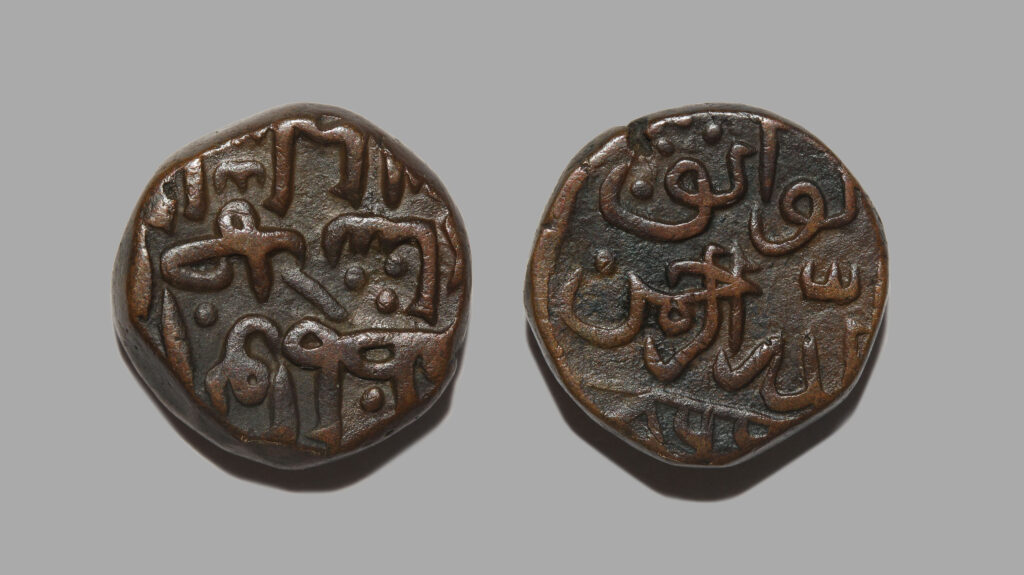
Copper coin issued by Nizam al-Din Ahmad Shah III of the Bahmani Sultanate, AH 866-867 1461-1463 CE, image © Sarmaya Arts Foundation
In its 180 years of reign, the Bahmani Sultanate had 18 rulers. Of them, five were murdered, three were deposed, two died of excessive drinking and another two were blinded. This was a time of intense rivalries, both within the empire and without, making for great volatility in the Deccan.
Abul Muzaffar Alauddin Bahman Shah founded the Sultanate in 1347. His original name was Hasan Gangu, suggesting a mixed Hindu-Muslim heritage. His reign began with a consolidation of power in the Konkan. On this foundation, successive Sultans built eastwards to wrest control of Warangal from the Kakatiyas. The Bahmanis were almost always at war with the Vijayanagara kings over the Raichur Doab, a fertile piece of land fed by the Krishna and Tungabhadra rivers.
While the Chalukyas and Rashtrakutas incorporated local policies, cultures and even rituals into their administration, Bahmani statecraft and style was influenced by Central Asia. Between the 15th and 16th centuries, following Timur’s attacks in the north-west, a considerable number of immigrants called Afaqis arrived in the Deccan from Central Asia and Iran. Some also came seeking military and administrative jobs with the Bahmanis.
Clashes began to erupt between the Dakhanis and the Afaqis. This coupled with the growing ambitions of the local rulers or amirs led to the disintegration of the Bahmani Sultanate. By the 1520s, five amirs had asserted their autonomy. These were the Imad Shahis of Berar in the far north, the Nizam Shahis of Ahmadnagar in the northwest, the Qutb Shahis of Golconda in the east, the Adil Shahis of Bijapur in the west and the Barid Shahis of Bidar in the centre.
Vijayanagara empire
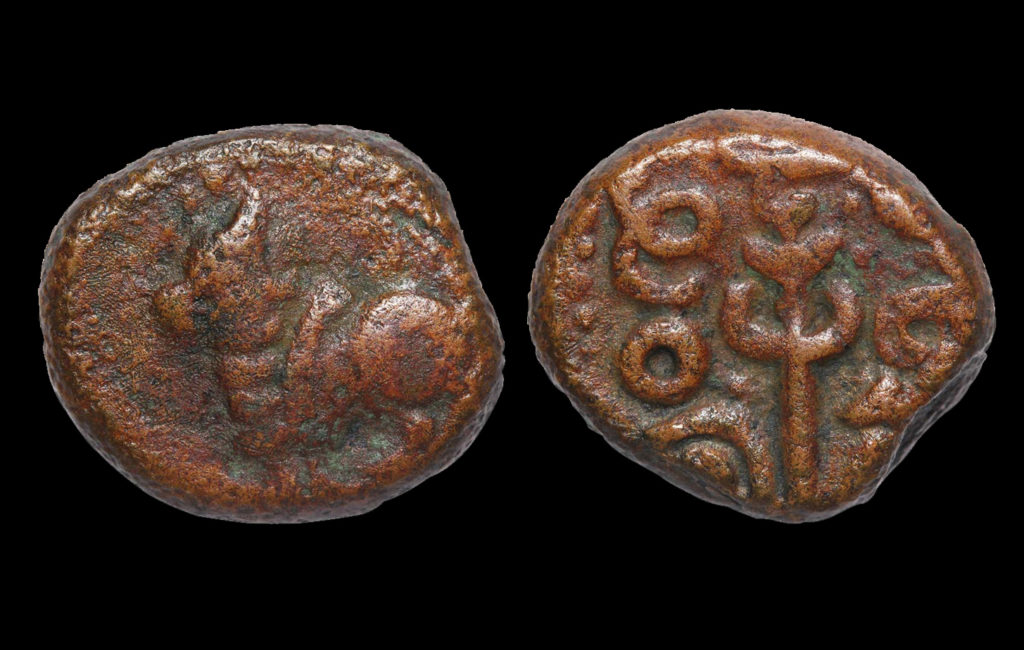
Copper vital issued by Krishnadevaraya of the Vijayanagara empire, 1509-1530 CE, image © Sarmaya Arts Foundation
The earliest written record of the founders of the Vijayanagara empire appeared in the14th Century, when brothers Harihara and Bukka are identified as local chieftains in the Hoysala empire. When the Deccan was annexed by the Delhi Sultanate, they became amirs under Muhammad bin Tughlaq. Harihara and Bukka conquered the territories of the waning Hoysala dynasty, south of the river Krishna, and in 1346 CE, they established the Vijaynagara empire.
They gave themselves the title of Hinduraya Suratrana and co-opted the emblem of the boar from the Chalukyas of Vatapi. After Harihara’s death, Bukka succeeded in bringing the state under his rule and establishing a feudatory system. He would also expand the dynasty into the Tamil lands, something no other Deccan power was able to achieve. This unlocked a fresh source of revenue, which he used to build and restore cities and holy places. Subsequent Vijayanagara rulers would patronise literature, art and architecture. One of their greatest living legacies is the city of Hampi.
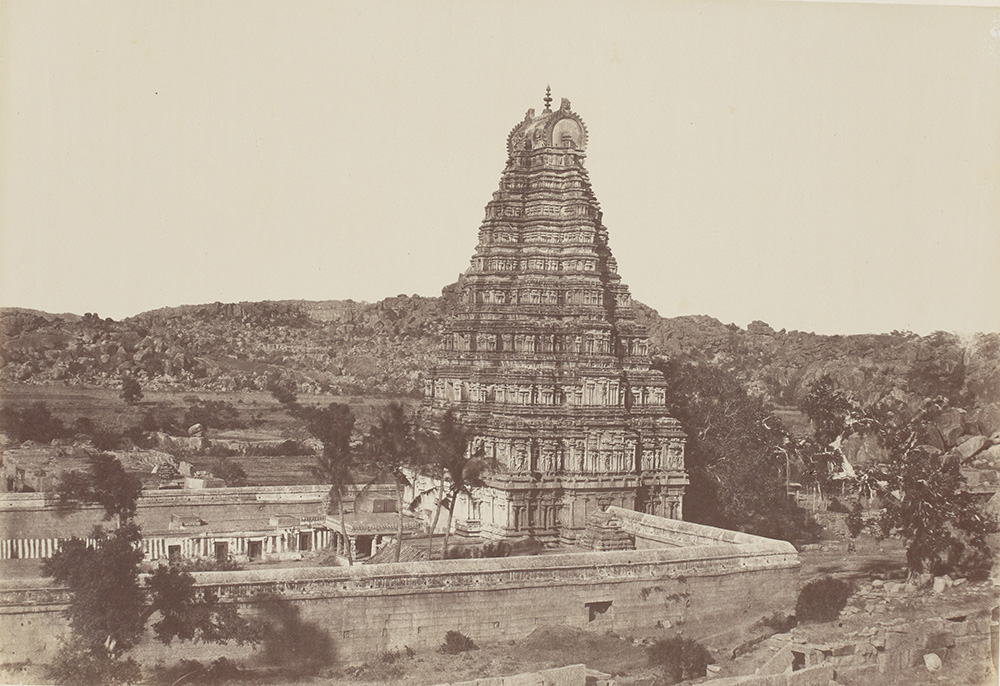
'Gopuram of the Virupaksha Temple, Vijayanagara', 1857, William Henry Pigou, image © Sarmaya Arts Foundation
In the 1520s, the disintegration of the Bahmani Sultanate would play into the hands of the empire, under their most prominent king Krishnadevaraya. He would conquer the Raichur doab and seize both Bijapur and Golconda. However, soon after Krishnadevaraya’s death the Deccan Sultanates would unite to challenge and defeat the Vijayanagaras. In 1565 CE, the empire’s capital would be sacked and its existence prolonged till the 17th Century only on the backs of their vassals. In this video, Sarmaya founder Paul Abraham talks briefly about the politics of the late Vijayanagara period.
Deccan Sultanates
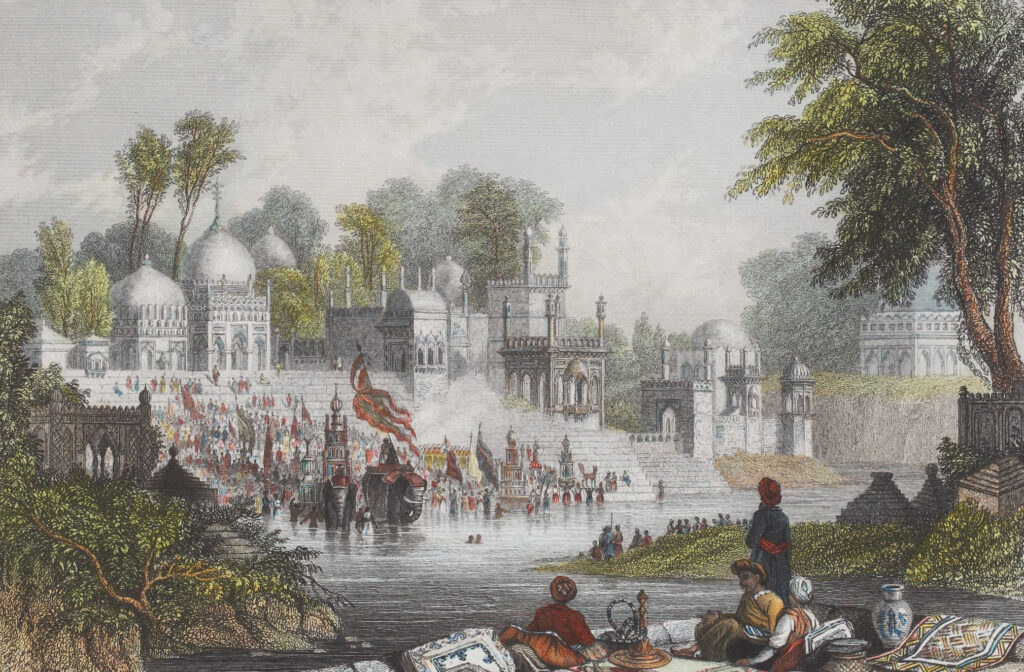
Dulha Shah Abdul Rehman Ghazi Dargah in Achalpur aka Elichpur, once the capital of the Berar Sultanate, engraving, 1839, image © Sarmaya Arts Foundation
The Deccan Sultanates of Bijapur, Ahmadnagar, Bidar, Berar and Golconda led shorter, even more tumultuous lives than their predecessors the Bahmani Sultans. They existed in a constant state of rivalry for dominance over the Deccan, sometimes forming short-term alliances to square off against each other. In the 1490s, Bidar and Bijapur would unite to defeat Ahmadnagar; in the early 1550s, Ahmadnagar allied with Golconda and the Vijayanagaras to ward off attacks from Bijapur; and in 1565, Ahmadnagar, Bijapur, Bidar, Berar and Golconda would pool their resources to defeat the Vijayanagara empire.
Nizam Shahis
The first to attain autonomy were the Nizam Shahis in the late 1480s. Their state was Ahmadnagar, named for its founder Ahmad Bahri Nizam Shah. Ahmadnagar was almost always threatened by attacks from Bijapur, only finding brief respite during an alliance between the power between 1565 and 1588. The two decades of stability allowed Ahmadnagar to annexe the declining kingdom of Berar and amass great wealth. Enough to commission the building of grand monuments, like Farah Bagh, in the Persian style, and Damri mosque, created in a new Deccani style. The paintings of this era are regarded as the earliest Deccani miniatures. Ahmadnagar’s prosperity caught the attention of the Mughals and eventually, the kingdom fell to their armies in 1636.
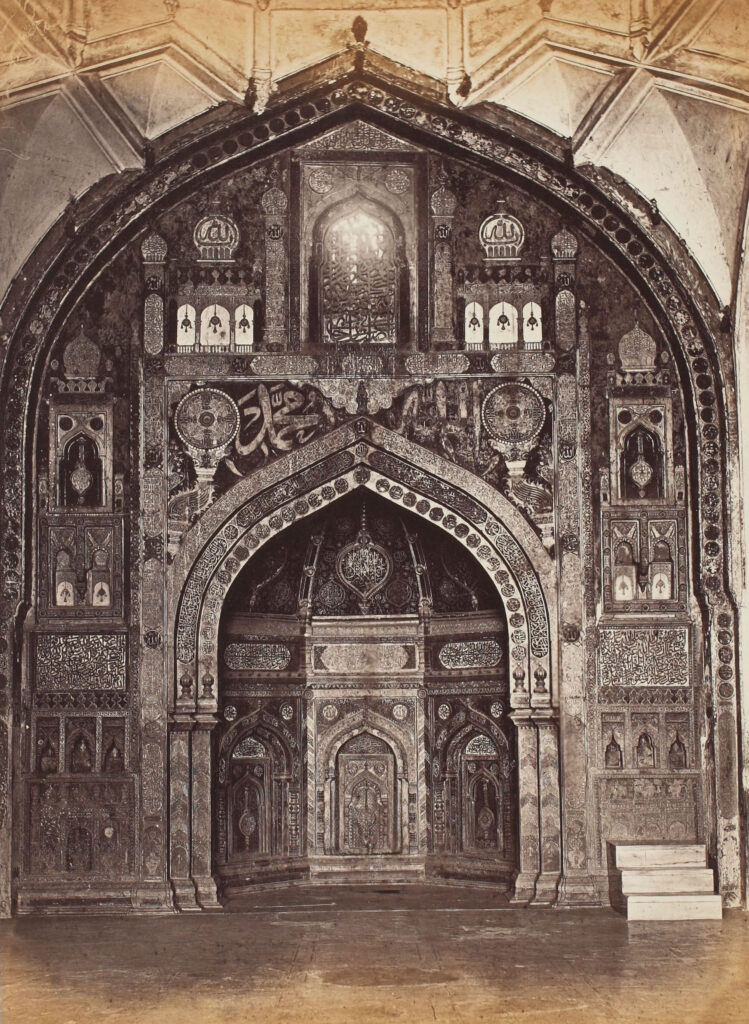
Mihrab at the Jam Masjid, Bijapur, ED Lyon, image © Sarmaya Arts Foundation
Bijapur Sultans
Following Ahmadnagar’s footsteps, Bijapur under the Adil Shahis would declare independence from the Bahmanis in the last years of the 15th Century. Years of war and loss would follow, as they faced off against the Barid Shahs of Bidar supported by Vijayanagara’s King Krishnadevaraya. Fortune finally turned in Bijapur’s favour in 1535, when its illustrious Prime Minister Asad Khan led military victories against Ahmadnagar and Vijayanagara. When the latter empire fell, Bijapur became a wealthy state and its Sultans embarked on ambitious projects like the building of the Jami Masjid. The empire annexed the kingdom of its former enemy, Bidar, and turned its attention further south. The Adil Shahis profited from maritime trade via ports they controlled on the Arabian Sea, leading to a golden age. Their fortunes secured and growing, the Bijapur Sultans began to patronise Dakhani literature, miniature paintings and architectural feats, like the building of the second largest dome in the world at the Gol Gumbaz. Eventually, they too would meet the fate of the other Deccan Sultanates and be annexed by the Mughals in 1657.
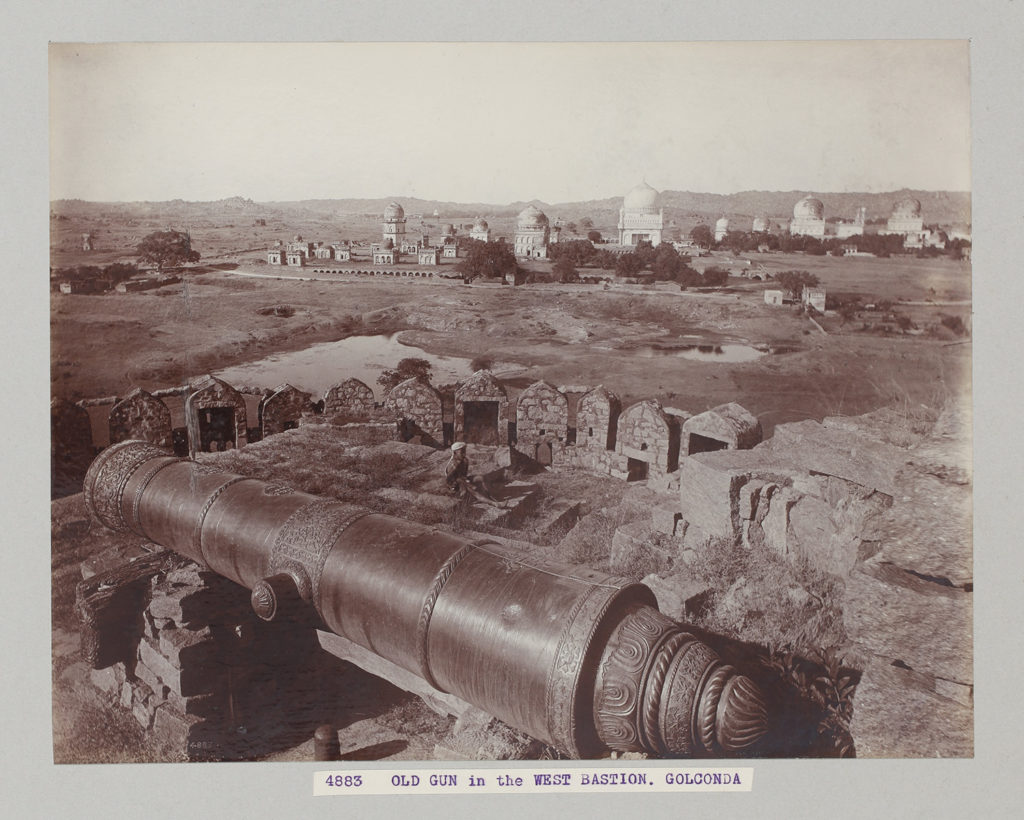
Old Gun with the West Bastion (Fateh Rahbar Gun), Golconda, Hyderabad, 1880s, Lala Deen Dayal, image © Sarmaya Arts Foundation
Qutb Shahis
The Qutb Shahis were the vassals of the Bahmani Sultanate, belonging to the royal Turkic Qara Qoyunlu tribe. In 1487, Quli Qutb al-Mulk was made an amir and put in charge of quelling rebellions against the Bahmanis. By 1512, however, he had founded his own empire. Golconda was a fortified city built around the only diamond mine in the Subcontinent, birthplace of famous diamonds like the Koh-i-Noor, the Hope Diamond and the Daria-e-Noor. The Qutb Shahis established the city of Hyderabad with the beautiful Charminar as its focal point. Like Bijapur, Golconda’s political and military ambitions were focused on the south even as Mughal forces threatened its borders in the north. In time, Golconda became a Mughal protectorate until it was besieged by Aurangzeb in 1656. Click here to pick up the story of Hyderabad as it continued under the Nizams.
References
- Kanisetti, Anirudh Lords of the Deccan: Sothern India from the Chalukyas to the Cholas, Juggernaut, New Delhi, 2022 Pg 20-487
- Pillai, Manu S. Rebel Sultans: The Deccan from the Khilji to Shivaji, Juggernaut, New Delhi 2018; pg 35-107
- Michell, George. Zebrowski, Mark. The New Cambridge History of India I: 7 Architecture and Art of the Deccan Sultanates, Cambridge University Press, UK, 2006, pg 4-23
- Ed Sardar, Marika. Haidar, Navina N. Sultans of the South, Art of India’s Deccan Courts 1323-168, The MET, New York, 2011, pg 2-11



